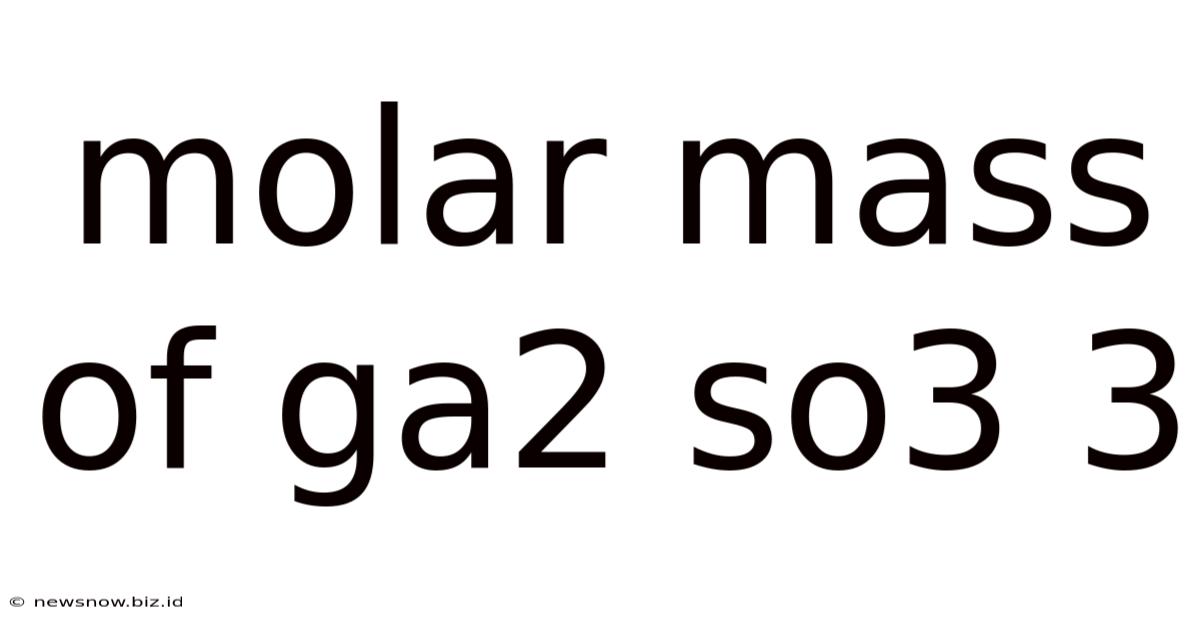Molar Mass Of Ga2 So3 3
New Snow
May 11, 2025 · 4 min read

Table of Contents
Unveiling the Molar Mass of Ga₂(SO₃)₃: A Comprehensive Guide
Determining the molar mass of a compound is a fundamental concept in chemistry, crucial for various calculations and analyses. This comprehensive guide delves deep into the process of calculating the molar mass of gallium sulfite, Ga₂(SO₃)₃, providing a detailed explanation and addressing common misconceptions. We will explore the underlying principles, step-by-step calculations, and practical applications of this crucial chemical parameter. This in-depth exploration will not only clarify the calculation but also enhance your understanding of stoichiometry and chemical formulas.
Understanding Molar Mass
Molar mass, expressed in grams per mole (g/mol), represents the mass of one mole of a substance. A mole is a fundamental unit in chemistry, defined as the amount of a substance that contains Avogadro's number (approximately 6.022 x 10²³) of elementary entities, such as atoms, molecules, or ions. Therefore, the molar mass of a substance is essentially the sum of the atomic masses of all the atoms present in one molecule of that substance. This requires understanding the chemical formula and accessing a periodic table to obtain the atomic masses of each constituent element.
Deconstructing the Chemical Formula: Ga₂(SO₃)₃
The chemical formula Ga₂(SO₃)₃ represents gallium sulfite. Let's break down the formula to understand its composition:
- Ga: Represents the element gallium.
- S: Represents the element sulfur.
- O: Represents the element oxygen.
- ₂: Indicates two gallium atoms in one molecule of gallium sulfite.
- ₃: Indicates three sulfite (SO₃) groups in one molecule of gallium sulfite. This means there are three sulfur atoms and nine oxygen atoms (3 x 3 = 9) per molecule.
This detailed breakdown is crucial for accurately calculating the molar mass.
Step-by-Step Calculation of the Molar Mass of Ga₂(SO₃)₃
To calculate the molar mass of Ga₂(SO₃)₃, we need the atomic masses of gallium (Ga), sulfur (S), and oxygen (O). These values can be found on a standard periodic table. While atomic masses vary slightly depending on the isotopic composition, we will use the standard average atomic masses for this calculation.
1. Identify Atomic Masses:
- Ga (Gallium): Approximately 69.72 g/mol
- S (Sulfur): Approximately 32.07 g/mol
- O (Oxygen): Approximately 16.00 g/mol
2. Calculate the Total Mass of Each Element:
- Gallium (Ga): 2 Ga atoms x 69.72 g/mol/Ga atom = 139.44 g/mol
- Sulfur (S): 3 S atoms x 32.07 g/mol/S atom = 96.21 g/mol
- Oxygen (O): 9 O atoms x 16.00 g/mol/O atom = 144.00 g/mol
3. Sum the Masses of All Elements:
Total molar mass = Mass of Ga + Mass of S + Mass of O
Total molar mass = 139.44 g/mol + 96.21 g/mol + 144.00 g/mol = 379.65 g/mol
Therefore, the molar mass of Ga₂(SO₃)₃ is approximately 379.65 g/mol.
Significance and Applications of Molar Mass
Understanding and accurately calculating the molar mass of Ga₂(SO₃)₃, or any compound for that matter, has far-reaching implications across various chemical disciplines:
1. Stoichiometric Calculations:
Molar mass is fundamental in stoichiometry, the area of chemistry dealing with quantitative relationships between reactants and products in chemical reactions. It allows us to convert between mass and moles, a crucial step in many calculations, including determining limiting reactants, theoretical yields, and percent yields.
2. Solution Chemistry:
In solution chemistry, molar mass is used to calculate molarity (moles of solute per liter of solution), a critical measure of solution concentration. This is essential for various applications, from titrations to pharmaceutical preparations.
3. Gas Laws:
The molar mass of a gas is essential for applying the ideal gas law (PV = nRT), allowing us to determine the volume, pressure, or temperature of a gas given its mass and other parameters.
4. Chemical Analysis:
Molar mass plays a vital role in various analytical techniques, including gravimetric analysis, where the mass of a precipitate is used to determine the amount of a substance in a sample.
Potential Sources of Error and Considerations
While the calculation is relatively straightforward, potential sources of error should be considered:
- Rounding Errors: Rounding atomic masses during intermediate calculations can lead to slight discrepancies in the final result. Using more decimal places for atomic masses will increase accuracy.
- Isotopic Variations: Atomic masses listed on periodic tables are average values. Variations in isotopic composition can influence the molar mass, albeit usually insignificantly for most practical purposes.
- Hydration: If the Ga₂(SO₃)₃ is hydrated (containing water molecules), the molar mass will be higher, as the mass of the water molecules must be included in the calculation. The formula would then need to be adjusted to reflect the water content (e.g., Ga₂(SO₃)₃·xH₂O).
Conclusion: Mastering Molar Mass Calculations
Calculating the molar mass of Ga₂(SO₃)₃, as demonstrated, is a crucial skill in chemistry. Understanding the underlying principles, performing the calculation systematically, and being aware of potential sources of error are essential for accuracy. This knowledge empowers you to confidently tackle more complex chemical calculations and deepen your understanding of chemical stoichiometry and its practical applications. The meticulous approach outlined here can be applied universally to calculating the molar mass of any compound, highlighting the importance of a strong foundation in chemical principles. Proficiency in these calculations lays the groundwork for further advancements in chemical studies and research.
Latest Posts
Related Post
Thank you for visiting our website which covers about Molar Mass Of Ga2 So3 3 . We hope the information provided has been useful to you. Feel free to contact us if you have any questions or need further assistance. See you next time and don't miss to bookmark.